Angela Rae Harris's Blog, page 13
October 6, 2025
The Nobel Prize in medicine goes to 3 scientists for key immune system discoveries
STOCKHOLM • Three scientists won the Nobel Prize in medicine Monday for discoveries about how the immune system knows to attack germs and not our own bodies.
The work by Mary E. Brunkow, Fred Ramsdell and Dr. Shimon Sakaguchi uncovered a key pathway the body uses to keep the immune system in check, called peripheral immune tolerance. Experts called the findings critical to understanding autoimmune diseases such as Type 1 diabetes, rheumatoid arthritis and lupus.
In separate projects over several years, the trio of scientists — two in the U.S. and one in Japan — identified the importance of what are now called regulatory T cells. Scientists are currently using those findings in a variety of ways: to discover better treatments for autoimmune diseases, to improve organ transplant success and to enhance the body’s own fight against cancer, among others.
“Their discoveries have been decisive for our understanding of how the immune system functions and why we do not all develop serious autoimmune diseases,” said Olle Kämpe, chair of the Nobel Committee.
Brunkow, 64, is now a senior program manager at the Institute for Systems Biology in Seattle. Ramsdell, 64, is a scientific adviser for San Francisco-based Sonoma Biotherapeutics. Sakaguchi, 74, is a distinguished professor at the Immunology Frontier Research Center at Osaka University in Japan.
The award, officially known as the Nobel Prize in Physiology or Medicine, is the first of the 2025 Nobel Prize announcements and was announced by a panel at the Karolinska Institute in Stockholm.
The physics prize will be announced on Tuesday, chemistry on Wednesday and literature on Thursday. The Nobel Peace Prize will be announced Friday and the Nobel Memorial Prize in economics Oct. 13.
The work that won the 2025 Nobel Prize in medicineThe immune system has overlapping ways to detect and fight bacteria, viruses and other intruders. But sometimes certain immune cells run amok, mistakenly attacking people’s own cells and tissues to cause autoimmune diseases.
Scientists once thought the body regulated this system only in a centralized fashion. Key immune soldiers such as T cells get trained to spot bad actors and those that go awry in a way that might trigger autoimmunity get eliminated in the thymus.
The Nobel winners unraveled an additional way the body keeps the system in check if immune cells later get confused and mistake human cells for intruders, which is what happens when a person has an autoimmune disease.
Sakaguchi said he “was curious about the mechanism of immune response that is supposed to protect oneself but also reacts to and attacks itself.”
His experiments in mice showed that the thymus pathway couldn’t be the only explanation. In 1995, he discovered a previously unknown T cell subtype, the regulatory T cells, that also could tamp down overreactive immune cells like a biological security guard.
Then in 2001, Brunkow and Ramsdell were working together at a biotech company investigating mice with an autoimmune disease. In painstaking work at a time when mapping genes was still an evolving field, they figured out that a particular mutation in a gene called Foxp3 was to blame — and quickly realized it could be a major player in human health, too.
“From a DNA level, it was a really small alteration that caused this massive change to how the immune system works,” Brunkow told AP.
Back in Japan, Sakaguchi noticed: “It was getting a lot of attention as one gene that can explain multiple autoimmune diseases, but still, why the gene causes the diseases was a mystery,” he said.
Two years later, Sakaguchi linked the discoveries to show the Foxp3 gene controls the development of those regulatory T cells so they’re able to curb other, overreactive cells.
Why this work mattersThe work opened a new field of immunology, said Karolinska Institute rheumatology professor Marie Wahren-Herlenius.
Until the trio’s research was published, immunologists didn’t understand the complexity of how the body differentiates foreign cells from its own, said Dr. Jonathan Schneck, a cellular immunology expert at Johns Hopkins University.
One goal now, Schneck said, is to figure out how to increase the number of regulatory T cells — also known as T-regs — to help fight autoimmune diseases. That would decrease the need for today’s therapies, which instead suppress the immune system in ways that leave patients vulnerable to infection.
The American Association of Immunologists said the winners’ work “has fundamentally reshaped our understanding of immune balance.”
The discoveries haven’t yet led to new therapies, Schneck cautioned. But “it’s incredibly important to emphasize, this work started back in 1995 and we’re reaping the benefits but yet have many more benefits we can reap” as scientists build on their work.
CU Buffs opponent lookahead: Injured, vulnerable No. 22 Iowa State comes to Boulder
Just five of the old Big Eight remain in what has become a very different, new-look, 16-team Big 12 in the 2020s.
Last year, Colorado welcomed Kansas State and Oklahoma State to Boulder and traveled to Kansas City to face Kansas.
This Saturday (1:30 p.m. FOX), the reunion tour continues as the Buffaloes host the final of their former pals, No. 22 Iowa State, at Folsom Field.
The two programs have met 65 times since 1946, but not since 2010 — a 34-14 win for CU in its last season of a first stint in the Big 12.
 Colorado’s Patrick Mahnke, top center, and Nick Kasa, bottom, sack Iowa State’s Austen Arnaud as the ball is forced out and returned for a Colorado touchdown in the fourth quarter of a NCAA college football game in Boulder, Colo. on Saturday, Nov.13, 2010. Arnaud suffered a season ending knee injury on the play. (AP Photo/ Matt McClain)
Colorado’s Patrick Mahnke, top center, and Nick Kasa, bottom, sack Iowa State’s Austen Arnaud as the ball is forced out and returned for a Colorado touchdown in the fourth quarter of a NCAA college football game in Boulder, Colo. on Saturday, Nov.13, 2010. Arnaud suffered a season ending knee injury on the play. (AP Photo/ Matt McClain)Here’s what to expect from the Cyclones:
Last time out
The injuries finally caught up to Matt Campbell’s team last Saturday.
The only other team in the conference with as long an injury list as the Buffs is Iowa State. The Cyclones were without 16 players against Cincinnati in Week 6, most notably the team’s star cornerback duo of Jeremiah Cooper and Jontez Williams, who are both out for the season.
With safety Khijohnn Cummins-Coleman and kicker Kyle Konrady also out against the Bearcats, it became too much to overcome as ISU fell down 17-0 in the first quarter and despite rallying to cut the deficit to single digits in the fourth quarter, Cincy wound up holding on for a 38-30 victory that ended the Cyclones’ unbeaten run to start the season.
Even though the Iowa State offense was able to move the ball down the field through the air, the defense couldn’t contain a Bearcats rushing attack that finished with over 260 rushing yards as a team.
The backbreaking play came from Cincinnati quarterback Brendan Sorsby, who found a wide open Caleb Goodie downfield for an 82-yard touchdown pass that put the Bearcats up by 16 with six minutes to play.
 Cincinnati wide receiver Caleb Goodie runs for a touchdown during the second half of an NCAA college football game against Iowa State, Saturday, Oct. 4, 2025, in Cincinnati. (AP Photo/Carolyn Kaster)
Cincinnati wide receiver Caleb Goodie runs for a touchdown during the second half of an NCAA college football game against Iowa State, Saturday, Oct. 4, 2025, in Cincinnati. (AP Photo/Carolyn Kaster)On offense
The big reason why Iowa State remains a threat in the Big 12 and a team that needs to be taken seriously is because of star quarterback Rocco Becht. The junior has taken a big, but expected step forward in his third year as the starter in Ames, completing nearly 65% of his passes for 1,417 yards and nine touchdowns to just two interceptions at the halfway point of his team’s season.
Even without a pair of 1,000-yard receivers that graduated from last year’s squad, Becht has still found ways to spread the ball around with five players recording 180 or more receiving yards to this point, led by Brett Eskildsen’s 321 yards and two touchdowns.
 Iowa State’s quarterback Rocco Becht throws a pass during the first half of an NCAA football college game against Cincinnati, Saturday, Oct. 4, 2025, in Cincinnati. (AP Photo/Carolyn Kaster)
Iowa State’s quarterback Rocco Becht throws a pass during the first half of an NCAA football college game against Cincinnati, Saturday, Oct. 4, 2025, in Cincinnati. (AP Photo/Carolyn Kaster)Former Buff Chase Sowell, who was a freshman on the 2022 CU team before transferring following Deion Sanders’ arrival, is also a player to note as he’s second on the Cyclones with 236 receiving yards and a touchdown.
ISU can also run the ball when it wants, too, with a pair of backs in Carson Hansen and Abu Sama III each having over 300 rushing yards.
On defense
The Iowa State defense is about as ‘middle of the pack’ as it gets.
Injuries have certainly played a factor for a unit that came into the season expecting to be one of the Big 12’s best, but the Cyclones currently rank seventh in the conference in scoring defense, eight in total defense, ninth in rush defense and seventh in pass defense.
 Iowa State defensive lineman Domonique Orange (95) tackles Cincinnati quarterback Brendan Sorsby (2) during the first half of an NCAA college football game, Saturday, Nov. 16, 2024, in Ames, Iowa. (AP Photo/Charlie Neibergall)
Iowa State defensive lineman Domonique Orange (95) tackles Cincinnati quarterback Brendan Sorsby (2) during the first half of an NCAA college football game, Saturday, Nov. 16, 2024, in Ames, Iowa. (AP Photo/Charlie Neibergall)With injuries to the top two cornerbacks on the other side, this could be a big game for the Buffs’ wide receivers that seem on the verge of a breakout. Omarion Miller, in particular, could be in for a big game if Kaidon Salter continues to heave the ball deep and give him a chance to make a play.
Still, the Cyclones have a few playmakers that can’t be ignored, namely defensive lineman Domonique Orange, who has one of the best nicknames in college football as he goes by ‘the Big Citrus.’ He’ll be a challenge for an improving CU run game, as will linebackers Kooper Ebel and Caleb Bacon.
The Iowa State Cyclones file
Record: 5-1 (2-1 Big 12)
Head coach: Matt Campbell (10th season, 69-52 record)
Offensive coordinator: Taylor Mouser (10th season at ISU, 2nd as OC)
Defensive coordinator: Jon Heacock (10th season)
Names to know: QB Rocco Becht, RB Carson Hansen, RB Abu Sama III, WR Brett Eskildsen, WR Chase Sowell, OT James Neal, DL Domonique Orange, LB Kooper Ebel, DB Marcus Neal Jr., LB Caleb Bacon
Kickoff: 1:30 p.m. (FOX)
Betting line: Colorado +3.5 (ESPN Bet)
Colorado State Patrol writes tickets to truckers without chains
Getting locked in a traffic jam behind a tractor-trailer stuck on snow-and-ice covered highways in the mountains is almost a tradition for Colorado drivers, who can face hours of delays when truckers don’t have, or don’t put on tire chains when the law requires them.
Colorado State Patrol troopers began cracking down on chain violations by inspecting trucks at ports of entry starting Oct. 1, a month after the Colorado law kicked in. All commercial vehicles are supposed to stop at ports of entry, but sometimes don’t.
On Oct. 1, troopers and Port of Entry officers conducted chain law inspections on I-70 near Dotsero, at the eastern end of Glenwood Canyon.
In one day, the inspectors made 468 contacts, issued 102 citations, 50 of which were chain violations. They contacted one driver without a commercial driver’s license and 70 “port runners,” or commercial vehicles who failed to stop for inspection. Among all of the contacts the chain law compliance rate was 89.5%.
Colorado law requires all commercial vehicles to carry tire chains between September 1 and May 31 each year. It applies to commercial vehicles with a combined weight of more than 16,000 pounds or that carry 16 or more people.
Glenwood Canyon is prone to big-rig crashes in the winter due mostly to truckers driving too fast on the icy highway.
Vail Pass is another hot spot for truck accidents.
Eastbound I-70 was closed near Vail January 8, for a crash where a westbound commercial vehicle crossed the median and struck another truck and passenger vehicles traveling eastbound. The highway was closed again on January 14 for a hazardous materials cleanup of leaking diesel fuel from that crash.
In a Febuary 4, 2025 letter to Gov. Jared Polis, Vail officials claimed that, based on information from the state, in 2024 there were 99 full closures of highways amounting to 161 hours and an estimated economic impact “exceeding $300 million dollars.”
“There is now a $1.6 million hit to the Colorado economy every hour that I-70 is closed,” said the Colorado Department of Transportation in a December 18, 2024 newsletter.
Evan Rawal’s predictions on NHL awards, Stanley Cup champ | 2025-26 Avalanche Preview
With the 2025-26 NHL season getting underway Tuesday, here are Evan Rawal’s predictions for the major award winners, conference finalists, and, yes, the Stanley Cup champion:
Hart Memorial Trophy (MVP of regular season) – Jack Eichel, Vegas Golden Knights
Eichel is Mr. Everything for Vegas and finished fifth on the Hart ballot last season. With 100-point winger Mitch Marner now by his side, he’ll reach a new level and take home the trophy.
Vezina Trophy (Top goal tender) – Igor Shesterkin, New York Rangers
The 29-year-old will take home his second Vezina after carrying an average New York team to the postseason. The Rangers go as far as Shesterkin carries them.
James Norris Memorial Trophy (Top goal defenseman) – Cale Makar, Colorado Avalanche
It’ll be a battle between Makar and Quinn Hughes of the Vancouver Canucks for the foreseeable future for the Norris, but Makar will take home his second straight after flirting with a 100-point season.
Calder Memorial Trophy (Rookie of the Year) – Ivan Demidov, Montreal Canadiens
If Zeev Buium catches his footing in Minnesota, he’ll be Demidov’s biggest competition, but the Russian with the magic hands will beat him out.
Rocket Richard Trophy (Top goal scorer – Connor McDavid, Edmonton Oilers
McDavid decided he wanted to score goals a few years back and dropped 64 in one year. He’s mentioned wanting to do that again this year, and when he puts his mind to something, no one has shown they can really stop him.
Art Ross Trophy (Top point scorer) – Nikita Kucherov, Tampa Bay Lightning
Can anyone slow down the Russian in the regular season? No one has shown they can, so it’s a safe bet that he’ll take home this award yet again.
Presidents’ Trophy (Top overall record) – Carolina Hurricanes
Carolina is a very good regular season that will rack up points playing all the bad teams in the Metro. Whether that regular season success will finally translate to a Stanley Cup is very much up in the air.
Eastern Conference final – Tampa Bay Lightning vs. Carolina Hurricanes
The Hurricanes will find themselves in a familiar spot, while the Lightning will take advantage of a tired Panthers team missing their most important player.
Western Conference final – Avalanche vs. Vegas Golden Knights
It’s about time we see the last two Cup winners to come out of the West meeting again in the postseason. This time, a trip to the final will be on the line. Two stacked teams that would put on one heck of a show.
Stanley Cup champion – Vegas Golden Knights
Vegas is a stacked roster up and down with a general manager who won’t be afraid to make improvements come the trade deadline.
The Denver Gazette’s unfinished spooky story needs an ending
The Denver Gazette wrote the beginning of a spooky tale. How it ends is up to you. Creative writers in grades 1-8 are invited to finish the story, in 250 words or fewer, for the chance to win a 2026 Elitch Gardens season pass (also valid for the rest of 2025) and have their entry published in The Denver Gazette.
There will be two winners: One for grades 1-5 and one for grades 6-8. Winners will be judged on creativity, grammatical excellence and adherence to the 250-word count. Submit entries by Oct. 26 via this attached form. Entries must include the writer’s full name, grade level, school and contact information. Winners will be announced on Halloween, Oct. 31.
A Haunting on Riverdale RoadIt was a frigid fall night on a lonely, dark road.
I had read the warning signs when I drove up Riverdale Road to meet some friends. “WARNING: Hitchhikers may be demons,” read one sign. “This road is cursed,” read another.
My friend had told me about a portal to another world that was somewhere along Riverdale Road. A portal that allowed spirits to roam freely in the night.
But I completely shrugged off the warnings and stories.
Riverdale Road, after all, was a beautiful 11-mile stretch of perfectly smooth pavement that wound through quiet open spaces and elegant, tall cottonwood trees. There was nothing to be afraid of.
When I left my friend’s house that night, I turned down Riverdale Road and peered into the darkness. I noticed just how eerie things felt after dark.
That’s when I saw him.
He was tall, lanky and ghostly pale, and he was running alongside my car. I wasn’t driving fast, but I also wasn’t driving slow. How was he keeping up? It was a chilly night, but no steam was coming from his breath as he ran. That’s when he turned, looked at me, and tapped on my window.
I sped down the road as far as I could drive and stopped when I finally came to a stop sign. I let out a huge breath of relief. I could no longer see him.
That’s when she appeared, right in the middle of the road…..
One winner from each grade bracket (1-5 and 6-8) will receive an entire season of fun for 2026, plus the rest of 2025 including Fright Fest and Elitch Holidays. Other Elitch Gardens season pass benefits include free parking, tickets for friends, a souvenir cup, entry to shows and events, dive-in movies, fireworks shows and over 150 days to play on the 54 rides and attractions.
Todd Siler’s ‘neuroimpressionism’ exhibited at Madden Museum
The word “brainiac” might best describe Todd Siler, a Denver- and New York City-based science-artist. Both cerebral and spiritual, part Albert Einstein and part William Blake, in 1986, Siler was the first person to receive an Interdisciplinary Studies PhD in psychology and art from the prestigious Massachusetts Institute of Technology (MIT). Siler’s focus long has been the human brain, and his colorful artworks reflect the complexities of his own gray matter.
 Todd Siler’s large-scale works pose big questions about humanity and the cosmos. (Heather A. Longway © 2025)
Todd Siler’s large-scale works pose big questions about humanity and the cosmos. (Heather A. Longway © 2025)Siler’s exhibition titled “Metaphorming Time” will open Oct. 18 with a free and open-to-the-public artist reception from 5 to 8 p.m. in the Museum of Outdoor Arts (MOA) Madden Gallery at 6363 Fiddler’s Green Circle in Greenwood Village and show through Feb. 13, 2026. Walking through the still-under-installation exhibit with the keenly ever-inquisitive artist was mind-expanding given his astonishing subject matter which he considers “X-rays into the mind.”
Siler said: “Every object I make is meant to link your mind to looking at your own mental process.”
Siler is cosmic and charismatic, intellectually acrobatic. He is soft-spoken with loud ideas. For Siler, a fundamental building block is communication — the essence of his construct: the metaphorm.
The 10,000-square-foot Madden Gallery is expansive enough to show Siler’s large-scale paintings. Massive and luminous, Siler’s abstract works and his metal photo sculptures are compelling without understanding anything about the scientific subtexts of his neocortex — the way a peony is simply lovely to behold without knowing an iota about the complexities of botany.
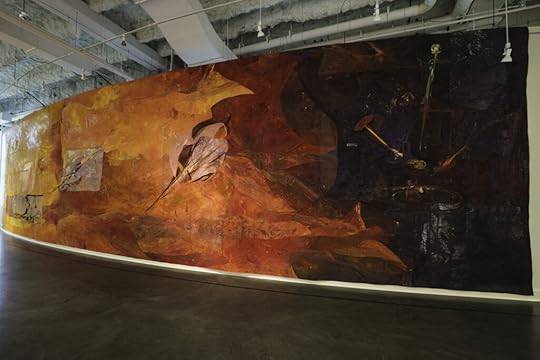 “Ascension,” Todd Siler’s 15-foot-by-60-foot painting collage originally was installed vertically. (Heather A. Longway © 2025)
“Ascension,” Todd Siler’s 15-foot-by-60-foot painting collage originally was installed vertically. (Heather A. Longway © 2025)Yet while many artists look to flowers or landscapes or the human figure for inspiration, Siler turns his eye — and his remarkable cerebrum — toward the mind-boggling details of cutting-edge science. Nanoparticles, for instance. Or the continuums of time and space. The cosmos. The nature of consciousness. The origin of intuition.
Or his own quicksilver concepts Siler calls “neurocosmology” or “the psychomirror” or “cerebral fusion.” Siler has created his own lexicon, in addition to his artworks.
In 2011, Siler received the Leonardo da Vinci World Award of Arts from the World Cultural Council. Like da Vinci, Siler is a multidisciplinary Renaissance man. He authored two books: “Think Like a Genius” and “Breaking the Mind Barrier.” MIT patented his printing process. He invented a technique to create his photo sculptures that allows him to bake his images into metal forms he cuts and welds.
“Todd tends to write on his pieces, and it’s his own beautiful handwriting, but it looks a little like Leonardo’s,” said Mary Lee Grisanti, who met Siler when they both attended Smith College. “I’ve known Todd 54 years. Todd is the least compartmentalized person I know,” said Grisanti, who chairs the film department at the School of Visual Arts in New York City.
Grisanti’s art collection includes works by Siler, and Grisanti has observed his progression.
“He has an understanding of things on a molecular and atomic level that has totally inspired him. As he went deeper into science, science found its way into his art. He didn’t change, he just developed, but it’s still pure Todd.”
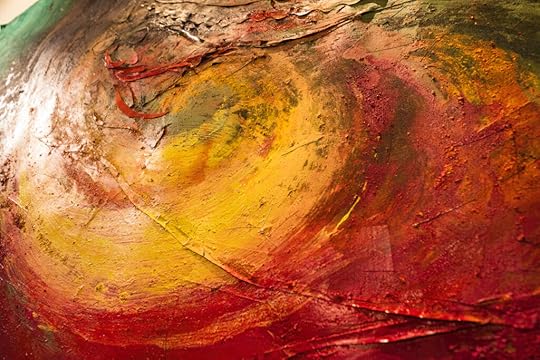 Todd Siler’s mixed-media artworks present color, texture and motion. (Heather A. Longway © 2025)
Todd Siler’s mixed-media artworks present color, texture and motion. (Heather A. Longway © 2025)With the tagline, “The past is always present in the future,” the exhibit presents one of Siler’ massive works titled “Ascension,” a 15-foot-by-60-foot painted collage commissioned for the lobby of Palazzo Verdi, the building housing the gallery. Siler originally installed “Ascension” vertically, but it now flows horizontally, a chiaroscuro illustrating how human beings evolved from the molecules of primal elements.
“We use ancient cultures. We’re building on concepts. The past, the present, the future — they’re intertwined,” Siler said.
‘There’s no such thing as luck. There is only foolishness and wisdom.’Siler is not only intelligent, but also wise. He’s the sort of man whose inner machinations seem almost visible in his frontal lobe when he speaks passionately about his art, the inner gears cranking his cerebellum’s engine of ingenuity. And though as he explains the scientific profundity of his art, one’s eyes might glaze over, they likely also will have stars in them because Siler takes on some of the most complex questions of our universe. He wrote his dissertation on the source of intuition as he pinpointed it in what he calls “the heart of the brain.” He has spent nearly 50 years of his career trying to sort out the same weighty, perhaps unanswerable questions.
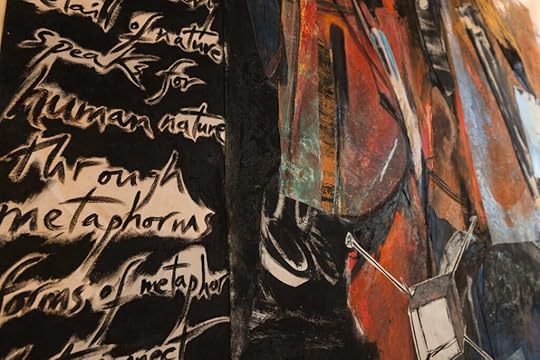 Many of Siler’s works include mark-making in the form of his ideas incorporated in his calligraphic handwriting (Heather A. Longway © 2025)
Many of Siler’s works include mark-making in the form of his ideas incorporated in his calligraphic handwriting (Heather A. Longway © 2025)“I wanted to learn about the brain through art,” he said, pointing out the textures in his paintings that suggest neurological constructs.
“When people ask ‘Where’s your studio?’ I say my brain is an R&D lab — always open,” said Siler, who grasps the mind and universe in 11 dimensions.
‘Knowledge is understanding your mistakes. Wisdom is learning from them.’Siler’s large-scale works pose big questions, and looking at his installation inspired by nanoparticles, he unleashed a litany of them: “We need to stop and question ourselves collectively. What do we need to understand to sustain humankind’s existence in the universe? What is our relationship to tech? How do we foster global cooperation? What does sustainable living look and feel like? Where are we going? How do we take the sum of human knowledge out – not just to our planet? How do we redefine progress? How can we best collaborate in the age of artificial intelligence? What can we do best of all by working together? And this quiet question, ‘What if we chose not to work together?’”
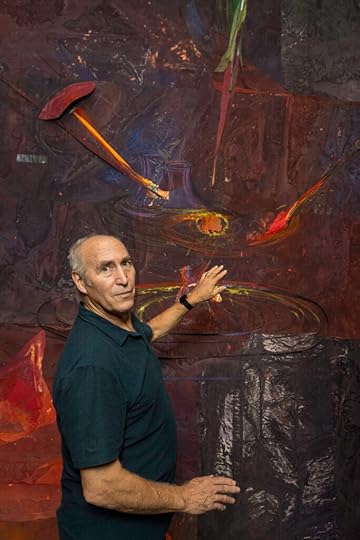 Todd Siler’s 50-year career has amalgamated science and visual art. (Heather A. Longway © 2025)
Todd Siler’s 50-year career has amalgamated science and visual art. (Heather A. Longway © 2025)He explained his work “Gambling on Earth” in a nutshell: “I always say, ‘Money may make the world go ‘round, but only love keeps it around.’ And it’s not the love of power,” Siler said. “This is like a roulette table, especially when we disregard our natural environment.”
‘Nature invents. Human nature innovates.’The natural environment is tantamount for Siler. When he’s not making art, Siler might likely be walking in the woods or sitting near a stream or enjoying an occasional cigar near a bonfire under a star-spangled sky. Siler draws inspiration from nature. Moreover, nature concerns him, and he takes a protective approach to our imperiled planet.
“We are absolutely so entwined in nature,” he said. “We literally have to understand our connection with the whole of nature to understand our impact and the way we’re using resources.”
Siler’s installation at Denver Museum of Nature & Science, titled “The History of Conflict Resolution,” emphasizes the need for human communication and cooperation. “If we can’t get that right, all the tech in the world will be for naught. It has to come down to understanding and awareness of different experiences of life or we’re forever locked in human conflict.”
Siler exhibits globally and has been represented by Ronald Feldman Fine Arts in New York City since 1980.
Robert Root-Bernstein, emeritus professor of physiology at Michigan State University and a MacArthur Fellow, met Siler in 1989.
“I was absolutely gobsmacked by Todd’s artwork. Here was a guy trained at MIT with a dual PhD in art and neuroscience whose artwork was about how we think and whose writing delved right into the deepest mysteries of the creative process,” said Root-Bernstein.
A colleague and friend who has collected about a dozen of Siler’s artworks, Root-Bernstein added: “We were both universalists trying to figure out how to integrate the best insights and inventions of the human race by bringing arts and sciences back into harmony in the tradition of great Renaissance figures.”
Root-Bernstein sees Siler’s art both as a visual cheerleader, of sorts, and a cautionary tale.
“Todd constantly asks how much better we could do if we could harness all the energy of human creativity to focus on the world’s most difficult challenges. Imagine, he asks us, what kind of innovative explosion would result from the fusion of mental energy that all of us have but so few of us share,” Root-Berstein said. “Todd’s art embodies all of this and more, a call to each one of us to not only see new possibilities but to join others in finding collaborative ways to implement them. Todd’s artwork is not something you just look at but something that makes you think and act in new, more creative ways.”
Taking in Siler’s exhibition at the Madden Gallery is akin to a quick visual art course hybridizing neurology, psychology, cosmology and philosophy. Siler’s philosophical musings are colorful, yet also dark. Our perilous world activates his nervous system, giving rise to anxiety.
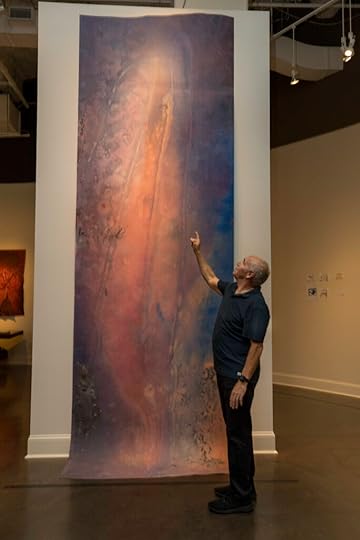 Todd Siler pictured with one of his pieces installed for his solo show titled “Metaphorming Time” on exhibit in the Madden Gallery in Greenwood Village from Oct. 18 to Feb. 13. (Heather A. Longway © 2025)
Todd Siler pictured with one of his pieces installed for his solo show titled “Metaphorming Time” on exhibit in the Madden Gallery in Greenwood Village from Oct. 18 to Feb. 13. (Heather A. Longway © 2025)“We are at a fragile inflection point. If we still are at war with one another, still at a level of disconnect, the stakes are so high with all the tech that can do us in,” Siler said. “This show is getting people to stand back a moment and think about their actions and behaviors and how we’re all on this planet and we have to work together in a unique way now. We have that opportunity now, and we can’t blow it. We really can’t blow it. I am on high alert, but I have,” Siler added, using one of his favorite metaphorms, “‘hopetimism.’”
More details at infor@moaonline.org
First-Ever World Solitaire Championship – Showcasing One of the World’s Most Beloved and Timeless Games – to be held in Miami this February!
Papaya, through its iconic title ‘Solitaire Cash’, is bringing the historic and iconic card game back to center-stage by launching its biggest competition to date, doling out $300,000 in total prizes for the most skilled players.
For the first time ever, Solitaire will take the world stage with the launch of the World Solitaire Championship (WSC), an international competition celebrating one of the most iconic and beloved games.
The First-Ever World Solitaire Championship is launching in Miami, bringing a skill-based twist to a timeless classic to the global stage. Organized by Papaya (formerly known as Papaya Gaming) — a leader in skill-based mobile gaming with 37M+ downloads and hundreds of millions of daily competitions — the event turns Solitaire into a truly social world-stage competition.
Papaya, a global leader in skill-based mobile entertainment, pairs players of similar skill levels to ensure every match is both fair and thrilling. Across its hit titles — including Solitaire Cash — Papaya powers hundreds of millions of daily competitions, giving players of all levels the chance to compete and win in a truly social, skill-based gaming experience.
Papaya announced today that the event, produced by Estars Studios and Executive Producer David Lee, will take place in February 2026 at Temple House Miami, South Beach’s premiere event venue. Players from around the globe will compete for prestige, the title of World Solitaire Champion, and a share of $300,000 in prizes.
For decades, Solitaire has been a cultural staple, played in living rooms, office cubicles, and on countless mobile devices. Papaya has transformed that solo pastime into a shared experience by connecting millions of real players through live, skill-based tournaments. The World Solitaire Championship adopts the same social format for the global stage, bringing players together in Miami for a weekend of competition, community, and celebration.
The World Solitaire Championship offers more than just gameplay. The 400 finalists will be flown to Miami for an all-expenses-paid weekend at the Fountainebleau, which includes five-star accommodations, exclusive entertainment, and the chance to connect with a vibrant community of players and fans. In addition to being crowned the first-ever World Solitaire Champion, the winner will take home $150,000, with total prizes of $300,000 up for grabs by Miami finalists.
“We believe play has the power to create meaningful connections that go far beyond the screen. Our vision is to bring people together through competition, community, and shared experiences – and the World Solitaire Championship is another step in making that vision a reality” Says Oriel Bachar, Co-Founder and CEO of Papaya.
At the heart of the World Solitaire Championship is Papaya’s mission to champion the power of play. The event reflects the company’s belief that play has the power to bring people together, transforming everyday play into moments of competition, joy, and shared community.
Solitaire Cash players can enter the World Solitaire Championship qualification phase via the game’s app from
Aspens aglow
 The setting sun casts a red glow on Chimney Rock and Courthouse Mountain on Sept. 29, 2025, on Owl Creek Pass east of Ridgway. (The Denver Gazette, Christian Murdock)
The setting sun casts a red glow on Chimney Rock and Courthouse Mountain on Sept. 29, 2025, on Owl Creek Pass east of Ridgway. (The Denver Gazette, Christian Murdock)
October 5, 2025
Denver area events for Oct. 6
If you have an event taking place in the Denver area, email information to carlotta.olson@gazette.com at least two weeks in advance. All events are listed in the calendar on space availability.
Monday
RiNo Arts District Food Tour — 1-4 p.m., Denver, $60 and up. Registration required: deliciousdenverfoodtours.com.
Live Music Mondays — With Emelise Munoz, 5-7 p.m., Cherry Cricket Littleton, 819 W. Littleton Blvd.; cherrycricket.com/littleton-live-music.
Blessthefall — 6 p.m., Summit Music Hall, 1902 Blake St., Denver, $37 and up. Tickets: summitdenver.com.
Dark Angel Fall 2025 Tour — With Sacred Reich, Vio-Lence, Midnight and Interceptor, 6 p.m., The Oriental Theater, 4435 W. 44th Ave., Denver, $47.50 and up. Tickets: theorientaltheater.com.
Pool Kids — 6:30 p.m., Marquis Theater, 2009 Larimer St., Denver, $24 and up. Tickets: marquisdenver.com.
Sipping N’ Painting Hampden — “Sunflower Burst,” 6:30-8:30 p.m., Sipping N’ Painting Hampden, 6461 E. Hampden Ave., Denver, $35. Registration required: sippingnpaintinghampden.com.
Goldings, Bernstein, Stewart Organ Trio — 7 and 9:30 p.m., Dazzle at Baur’s, 1080 14th St., Denver, go online for prices. Tickets: dazzledenver.com/#/events.
Conan Gray — With Hemlocke Springs, 8 p.m., Red Rocks Amphitheatre, 18300 W. Alameda Parkway, Morrison, go online for prices. Tickets: axs.com.
Every Little Thing: A Mini-musings Exhibit” — Through Oct. 18, Art Students League of Denver, 200 Grant St., Denver; asld.org.
“The 90s: Last Decade Before the Future” — Through Oct. 25, History Colorado Center, 1200 Broadway, Denver, go online for prices: historycolorado.org/exhibit/the-90s.
“Roni Horn: Water, Water on the Wall, You’re the Fairest of Them All” — Through Feb. 15, MCA Denver, 1485 Delgany St., Denver, go online for admission prices; mcadenver.org.
“Fuse Box: Sarah Sze” — Through July 2026, Denver Art Museum, 100 W. 14th Ave. Parkway, Denver, go online for prices: denverartmuseum.org.
CARLOTTA OLSON, The Denver Gazette
The Certainty of Uncertainty
There’s an old saying: Nothing is certain except death and taxes. But in today’s rapidly changing, global, hyper-connected world, uncertainty has joined the ranks of things we can expect. Markets move, politics surprise, and wildly innovative technology debuts seemingly every day, yet most investors believe they can correctly forecast the unknowable. Some (the financial media) are paid to play this guessing game, but most investors try to predict as a default of human nature. Participating in a system like financial markets leads many to believe they can beat said system. But this thinking error leads many astray, especially when they forget something essential: Their financial plan already accounts for the unpredictable.
Think back to 2008. Few predicted Lehman Brothers collapsing or the housing bubble bursting so quickly. Investors who believed home prices always rose, or that credit markets were safe, suddenly faced the unthinkable. More recently, the COVID-19 pandemic taught us that a virus across the world can reroute economies, stop travel, and rewire supply chains against all models. Add today’s geopolitical tensions, inflation spikes, rapid innovation, AI, energy transitions, demographic shifts … just naming them feels overwhelming.
Each unexpected change blindsided many investors. Yet a pattern appeared: Each crisis highlighted ever-apparent uncertainty. And in most cases, those who did not react emerged well ahead.
Remember that as investors, we are constantly on the precipice of uncertainty. We can never confidently know how anything will play out. No one can. So what should we do? Probably nothing, which is sometimes the hardest thing to do. With everything changing, we think we should be adapting. New circumstances require portfolio changes, right?
Take a step back for a moment and recognize your behavior. You are reacting. Reacting is a form of self-doubt. Remember, doubt gives the financial services industry ammunition to sell its products, as they are motivated to spotlight any friction and scare you into “just doing something.” And many unchecked reactions can wreck a portfolio.
How can long-term investors make rational decisions while reacting to short-term data? You can’t know exactly what will happen tomorrow, yet you can know that some degree of unexpected — even shocking — change is inevitable. That’s the certainty of uncertainty.
When faced with such uncertainty, I like to remember what we know.
We know that creating a plan and sticking to it works. If your goals are long-term, your plan should mirror that. You don’t invest money for today or tomorrow. You invest for 5, 10, 25, or 50 years later. How will an event impact your future? You can’t know for certain, but look back on history and remember (or imagine) how it felt to live through some of the aforementioned scenarios. Uncertainties come and go, but over a sufficient time horizon, markets have always been positive. All that really matters is that you have income when you need it and don’t overspend your earnings (income).
We also know that, historically, certain asset classes, such as ownership of businesses in the form of stock, provide superior long-term rates of return. But we know this benefit doesn’t come without short-term fluctuations. At any time, markets can pull back between 10–15%, and they typically do so at least once every 12 months. This is “normal” and should be viewed with joy rather than fear. We know this happens; we just can’t know “when.” Instead of inspiring fear, train yourself to recognize this as an opportunity.
When things go on sale, I like to buy, not run out of the store in terror. This approach takes courage and repetition. Long-term investors with a well-designed plan look at those market declines as opportunities, allowing them to acquire ownership from short-term traders at discount prices. On which side of that deal would you rather be?
To navigate this uncertainty long-term, we encourage all investors to set goals, make a plan, and save until it hurts. How much money you keep has a far more significant impact on your success than any investment return you may earn. Put time and the power of compounding to work for you. Stay focused on that strategy. Sometimes the best thing to do is nothing. In short:
Successful investing is often goal-focused and planning-driven. Failed investing is typically market-focused and current-event-driven.Successful investors stick with their plan over their lifetimes, making rare and subtle changes when circumstances warrant. Failed investors react continually to random economic and market developments.Today’s uncertainty is large, perhaps larger in perception than in many past eras because of the faster pace of change, more immediate information, and increasingly viral messaging. But we’ve walked similar paths before and survived (even prospered!) when we didn’t try to outrun fear or chase greed. When we accept that uncertainty is the only certainty, and then choose to stick with our plan, we model great investment behavior.
Have a plan that survives the unknown, live within your risk tolerance, stay diversified, be willing to endure short-term discomfort for long-term objectives, and do nothing when nothing needs to be done. That’s not passive; that’s discipline. That’s the investor’s power in a world where we can certainly expect a visit from this invisible friend we all share: uncertainty itself.
Securities and advisory services offered through LPL Financial, a registered investment advisor. Member FINRA/SIPC.
Content in this material is for general information only and not intended to provide specific advice or recommendations for any individual. All performance referenced is historical and is no guarantee of future results. All indices are unmanaged and may not be invested into directly. There is no guarantee that a diversified portfolio will enhance overall returns or outperform a non-diversified portfolio.
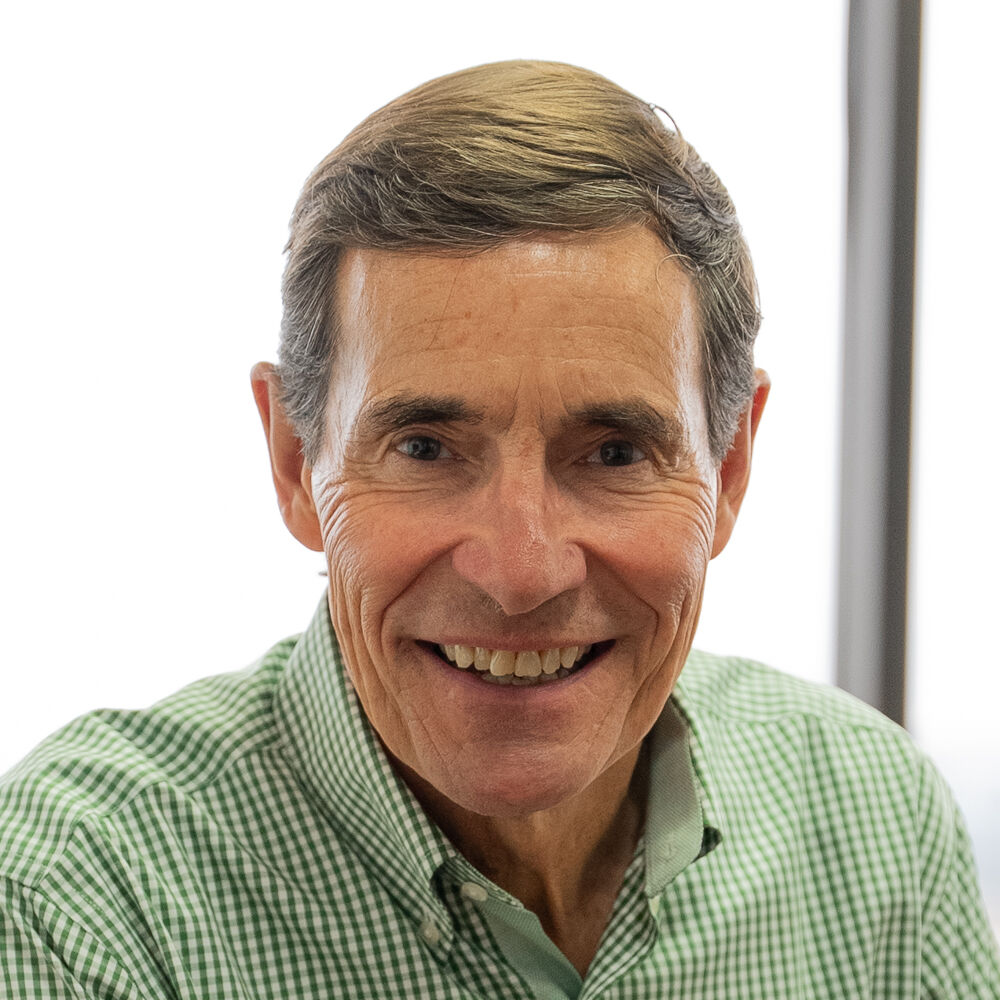 Steve Booren, Owner and Founder of Prosperion Financial AdvisorsAbout the author
Steve Booren, Owner and Founder of Prosperion Financial AdvisorsAbout the authorSteve Booren is the Owner and Founder of Prosperion Financial Advisors, located in Greenwood Village, Colo. He is the author of “Blind Spots: The Mental Mistakes Investors Make” and “Intelligent Investing: Your Guide to a Growing Retirement Income” and a regular media columnist. He was recently named a Barron’s Top Financial Advisor and recognized as a Forbes Top Wealth Advisor in Colorado.



